| 1 |
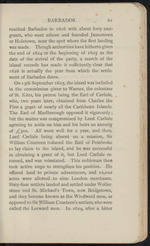 |
“...was included
in the commission given to Warner, the coloniser
of St. Kitts, his patron being the Earl of Carlisle,
who, two years later, obtained from Charles the
First a grant of nearly all the Caribbean Islands.
The Earl of Marlborough opposed it vigorously;
but the matter was compromised by Lord Carlisle
agreeing to settle on him and his heirs an annuity
of ^300. All went well for a year, and then,
Lord Carlisle being absent on a mission, Sir
William Courteen induced the Earl of Pembroke
to lay claim to the island, and he was successful
in obtaining a grant of it, but Lord Carlisle re-
turned, and was reinstated. This nobleman then
took active steps to strengthen his position. He
offered land to private adventurers, and 10,000
acres were allotted to nine London merchants.
Sixty-four settlers landed and settled under Wolfer-
stone and St. Michael’s Town, now Bridgetown,
and they became known as the Windward men, as
opposed to Sir William Courteen’s settlers, who were
called the Leeward...”
|
|
| 2 |
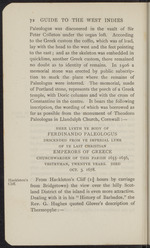 |
“...Hackleton’s
Cliff.
*j2 GUIDE TO THÉ WÉST INDIES
Paleologus was discovered in the vault of Sir
Peter Colleton under the organ loft. According
to the Greek custom the coffin, which was of lead,
lay with the head to the west and the feet pointing
to the east; and as the skeleton was embedded in
quicklime, another Greek custom, there remained
no doubt as to identity of remains. In 1906 a
memorial stone was erected by public subscrip-
tion to mark the place where the remains of
Paleologus were interred. The memorial, made
of Portland stone, represents the porch of a Greek
temple, with Doric columns and with the cross of
Constantine in the centre. It bears the following
inscription, the wording of which was borrowed as
far as possible from the monument of Theodoro
Paleologus in Llandulph Church, Cornwall:—
HERE LYETH YE BODY OF
FERDINANDO PALEOLOGUS
DESCENDED FROM YE IMPERIAL LYNE
OF YE LAST CHRISTIAN
EMPERORS OF GREECE
CHURCHWARDEN OF THIS PARISH 1655-1656,
VESTRYMAN, TWENTYE YEARS. DIED
OCT...”
|
|
| 3 |
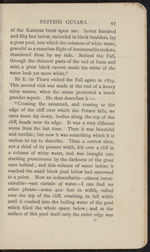 |
“...w
BRITISH GUIANA 97
of the Kaieteur burst upon me. Seven hundred
and fifty feet below, encircled in black boulders, lay
a great pool, into which the columns of white water,
graceful as a ceaseless flight of innumerable rockets,
thundered from by my side. Behind the Fall,
through the thinnest parts of the veil of foam and
mist, a great black cavern made the white of the
water look yet more white.”
Sir E. im Thurn visited the Fall again in 1879.
This second visit was made at the end of a heavy
rainy season, when the scene presented a much
grander aspect. He thus describes it:—
“Crossing the savannah, and coming to the
edge of the cliff over which the Potaro falls, we
once more lay down, bodies along the top of the
cliff, heads over its edge. It was a very different
scene from the last time. Then it was beautiful
and terrible; but now it was something which it is
useless to try to describe. Then a narrow river,
not a third of its present width, fell over a cliff in
a column of white water...”
|
|
| 4 |
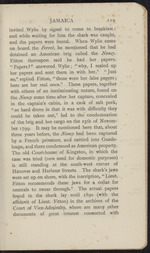 |
“...about
three years before, the Nancy had been captured
by a French privateer, and carried into Guade-
loupe, and there condemned as American property.
The old Court-house of Kingston, in which the
case was tried (now used for domestic purposes)
is still standing at the south-west corner of
Hanover and Harbour Streets. The shark s jaws
were set up on shore, with the inscription, “ Lieut.
Fitton recommends these jaws for a collar for
neutrals to swear through.” The actual papers
found in the shark lay until 1890 (with the
affidavit of Lieut. Fitton) in the archives of the
Court of Vice-Adnjiralty, where are many other
documents of great interest connected with...”
|
|
| 5 |
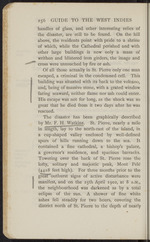 |
“...***** cross were untouched by fire or ash.
Of all those actually in St. Pierre only one man
escaped, a criminal in the condemned cell. This
building was situated with its back to the volcano,
and, being of massive stone, with a grated window
facing seaward, neither flame nor ash could enter.
His escape was not for long, as the shock was so
great that he died from it two days after he was
rescued.
The disaster has been graphically described
by Mr. F. H. Watkins. St. Pierre, nearly a mile
in length, lay to the north-east of the island, in
a cup-shaped valley enclosed by well-defined
spurs of hills running down to the sea. It
contained a fine cathedral, a bishop’s palace,
a governor’s residence, and spacious barracks.
Towering over the back of St. Pierre rose the
lofty, solitary and majestic peak, Mont Pelé
(4428 feet high). For three months prior to the
I great outburst signs of active disturbance were
manifest, and on the 25th April 1902, at 8 a.m.,
• the neighbourhood was darkened as by a total...”
|
|
| 6 |
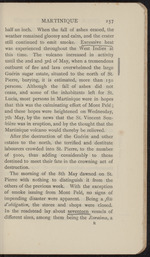 |
“...estates to the north, the terrified and destitute
labourers crowded into St. Pierre, to the number
of 5000, thus adding considerably to those
destined to meet their fate in the crowning act of
destruction.
The morning of the 8th May dawned on St.
Pierre with nothing to distinguish it from the
others of the previous week. With the exception
of smoke issuing from Mont Pelé, no signs of
impending disaster were apparent Being a fête
d'obligation, the stores and shops were closed.
In the roadstead lay about ^seventeen^ vessels of
different sizes, among them being the Roraima, a
R...”
|
|
